

Laser-generated surface structures create extremely water-repellent metals : NewsCenter. Professor Chunlei Guo has developed a technique that uses lasers to render materials hydrophobic, illustrated in this image of a water droplet bouncing off a treated sample.
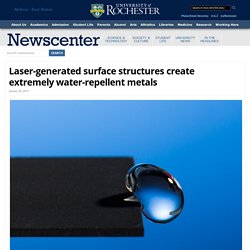
Photo by J. Adam Fenster / University of Rochester Scientists at the University of Rochester have used lasers to transform metals into extremely water repellent, or super-hydrophobic, materials without the need for temporary coatings. Super-hydrophobic materials are desirable for a number of applications such as rust prevention, anti-icing, or even in sanitation uses. However, as Rochester’s Chunlei Guo explains, most current hydrophobic materials rely on chemical coatings.
Occam’s Razor Applied to New 3D Printed UAV. The 3D printer may be nothing more than a tool, but it’s a tool which allows for the creation of complex objects that gives researchers, scientists, and artists a way to realize their vision of the future without resorting to painstakingly slow methods of construction.
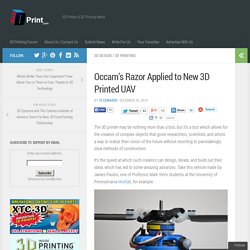
It’s the speed at which such creators can design, iterate, and build out their ideas which has led to some amazing advances. Take this vehicle made by James Paulos, one of Professor Mark Yim’s students at the University of Pennsylvania Modlab, for example. A traditional coaxial micro helicopter uses a large propeller motor, and in conjunction with two small servomotors to control thrust, pitch, and roll forces, generates the necessary forces through coordinated control of multiple actuators. Joytone Final Demo. Qualcomm Toq Smartwatch for Android Devices.
One Per Cent: Laser-powered 'unprinter' wipes documents in a flash. Paul Marks, senior technology correspondent The letters e, x and t in multiple toner colours have been laser vaporised - and the scanning electron micrograph shows where paper cellulose has been exposed by the beam (pic: CU) In offices the world over, heaps of printouts and photocopies from laser printers get used once before being discarded, or tossed on shelves to collect dust indefinitely.

But what if they could be wiped clean and used again? An engineering team at the University of Cambridge in the UK has figured out how to erase pages by vaporising common toners using a laser-based technique that doesn't damage the underlying paper. Toshiba of Japan already sells a special laser printer/copier (video) that uses a blue toner which can be almost completely erased with heat treatment. Introducing our smart contact lens project. You’ve probably heard that diabetes is a huge and growing problem—affecting one in every 19 people on the planet.
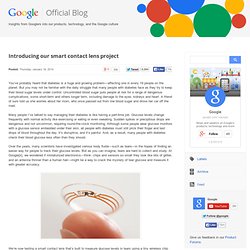
But you may not be familiar with the daily struggle that many people with diabetes face as they try to keep their blood sugar levels under control. Uncontrolled blood sugar puts people at risk for a range of dangerous complications, some short-term and others longer term, including damage to the eyes, kidneys and heart. A friend of ours told us she worries about her mom, who once passed out from low blood sugar and drove her car off the road. Many people I’ve talked to say managing their diabetes is like having a part-time job. Glucose levels change frequently with normal activity like exercising or eating or even sweating. Architecture. El Claustro, 2011.
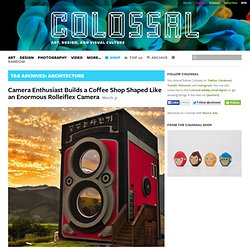
Querétaro, México. 10 x 10 x 11m La Capella, 2009. Piera, Spain. 5.5 x 6 x 15m. El Sótano de la Tabacalera, 2011. Madrid, Spain. 13 x 15 x 7m. Sala Buit, 2011. One Step Closer to Hover Boards: Three-Dimensional Mid-Air Acoustic Manipulation. While we’ve seen examples of objects suspended mid-air using quantum levitation and acoustic levitation, a team of three Japanese engineers from The University of Tokyo and the Nagoya Institute of Technology recently unveiled an ambitious device that uses sound waves to move objects through three dimensional space.
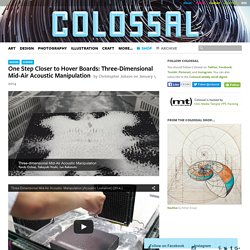
MIT Invents A Shapeshifting Display You Can Reach Through And Touch. We live in an age of touch-screen interfaces, but what will the UIs of the future look like?
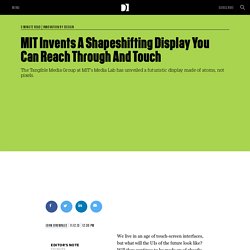
Invisible helmet deploys instantly to save bikers' lives. 'The more we looked into the mystery of Crispr, the more interesting it seemed' - Science - News. Crispr stands for “clustered regularly interspaced short palindromic repeats”, a devilishly contrived acronym which just about sums up why it was ignored for so long.

For nearly two decades after Japanese researchers first discovered Crispr in bacteria in 1987, scientists mostly dismissed it as “junk DNA”. In fact, the apparently nonsensical sequences within Crispr, which were repeated in palindromic order (the same backwards as forwards), did have a purpose and were far from junk. About six years ago, scientists discovered that these DNA sequences matched the genetic sequences of various viruses that attack bacteria, which led to the discovery of a sophisticated bacterial immune system.
Far from being junk, Crispr was actually a way of storing the genetic information of an invading virus in the form of a palindromic DNA sequence. “The more we looked into it, the more it seemed extremely interesting,” Professor Doudna said. Hiroshi Ishii. 3D Printing the Impossible: A Ship in a Bottle (Video) Outside In. Cubli – A cube that can jump up, balance, and – soon- walk across your desk. Update: New video of final robot!
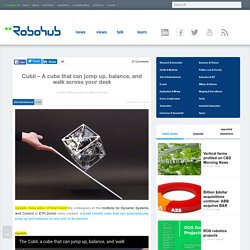
My colleagues at the Institute for Dynamic Systems and Control at ETH Zurich have created a small robotic cube that can autonomously jump up and balance on any one of its corners . Update This latest version of the Cubli can jumping up, balanc, and even “walk”. This new version is self contained with respect to power and uses three slightly modified bicycle brakes instead of the metal barriers used in the previous version. We are currently developing learning algorithms that allow the Cubli to automatically learn and adjust the necessary parameters if a jump fails due to the deterioration of the brakes and changes in inertia, weight, or slope of the surface. This robot started with a simple idea: Optotune Electrically Focus-Tunable Lenses. Scientists Invent Oxygen Particle That If Injected, Allows You To Live Without Breathing.
New Medical Discovery A team of scientists at the Boston Children’s Hospital have invented what is being considered one the greatest medical breakthroughs in recent years.

They have designed a microparticle that can be injected into a person’s bloodstream that can quickly oxygenate their blood. This will even work if the ability to breathe has been restricted, or even cut off entirely. New lithium-ion battery design that’s 2,000 times more powerful, recharges 1,000 times faster. Researchers at the University of Illinois at Urbana-Champaign have developed a new lithium-ion battery technology that is 2,000 times more powerful than comparable batteries. According to the researchers, this is not simply an evolutionary step in battery tech, “It’s a new enabling technology… it breaks the normal paradigms of energy sources. 3.14159265358979323846264338327950288419716939937510582097494459230781640628620899862803482534211706798214808651328230664709384460955058223172535940812848111. Non-pneumatic on pickup.flv. Deltawing - Home. New energy source for future medical implants: sugar.
Meet Pebble. Twine+Pebble: Connect your world to your wrist on Vimeo: Couch Mode. TED: Ideas worth spreading. Vijay Kumar: Robots that fly ... and cooperate. Trillibyte. Threshold broken for tiny lasers. 8 February 2012Last updated at 19:09 The cavity where the laser light is generated is less than 100 billionths of a metre across Scientists have shown off the smallest-ever laser that works at the colours of light used in telecommunications and at room temperature.
The tiny light sources switch on with no "threshold", meaning they operate much more efficiently than earlier, small laser attempts. They are just one-fifteenth the size of the light waves that they produce. The advance, described in Nature, may help bring about faster computers or in future "optical computing" approaches. Lasers are ubiquitous in daily life, from supermarket checkouts to CD players, but the quest for a smaller laser has been underway for years.
The principal application for the tiny lights would be in computing and telecommunications. But as the laser "cavities" in which light waves are amplified have shrunk to near the size of the light waves themselves, new effects have come into play. Cable TV idea. Transplant jaw made by 3D printer claimed as first. 6 February 2012Last updated at 09:07 ET A computer model of the fitted 3D-printed jaw is shown next to an image of the manufactured part.
Superstuff: When quantum goes big - physics-math - 16 January 2012. Read full article Continue reading page |1|2|3.